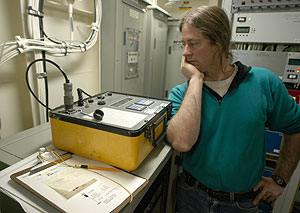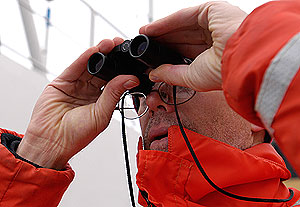|
|
 |
 |
Science
Crew Facts

David Roque Atienza coaches a girls basketball team in Cadiz, Spain. |
Daily Update
Calendar
Dispatch 13 - September 13, 2004
By C. A. Linder
Weather conditions: Overcast skies, snow flurries, 15 kt winds, 2-3 ft seas,
air temperature 35°F
Fishing for Moorings
The sky was gray and heavy this morning... the kind of sky that promises
snow and blustery winds. Dry powdery snowflakes whirled around the
ship as I made my way to the helicopter hangar to bid farewell and
good luck to Jim Ryder, John Kemp, and Dan Torres. Their work done,
it was back to dry land. Despite the foreboding weather, it was business
as usual for the aviation detachment.
Both of the HH-65 Dolphin helicopters were airborne by 9AM, safely
carrying their passengers to the Barrow airstrip.
 |
 |
| Seth weighs his options after discovering that the acoustic releases have failed. |
Click to enlarge
|
The first order of business after the helicopter flights was the recovery of the University of Alaska Fairbanks Barrow Canyon mooring. This mooring gave us trouble in July 2002 when we were stuck in thick brash ice and were forced to delay the deployment until later in the cruise. Last year and this year, though, that problematic ice is gone. September is the most ice-free month in the Arctic, and recently the summer icepack has been receding even further. Little did we know, though, that a different problem was lurking.
Seth Danielson and Jim Johnson didn't notice
anything wrong when they triggered the first acoustic release. The
mooring responded immediately, indicating that it was still there
and that it was in an upright position. Since this mooring is in very
shallow (80 meters) of water, they expected the lookouts to see the
mooring floats almost immediately. When the minutes ticked by and
nothing was sighted, they triggered a second release. The minutes
dragged by again, even slower, as they contemplated what this could
mean.
"We're going to have to drag for the mooring," Jim sighed.
 |
 |
| Tom grabs the binoculars to take a closer look at the recently sighted mooring. |
Click to enlarge
|
Last year we also had to drag for one of the moorings. The operation is time-consuming and difficult, plus there is the added danger of damaging the instruments in the process. A pair of anchors are lowered into the water a few hundred meters from the known position of the mooring. Then, the ship steams in a circle around the mooring, laying down a heavy cable on the seafloor. After circling the mooring position, the ship starts reeling in the line. This virtually guarantees that the cable comes into contact with the mooring, hopefully providing enough of a jolt to open the releases. The entire operation takes a few hours.
When the cable started streaming out behind the ship, principal investigator Tom Weingartner took up position on the O-3 level to watch for the bright yellow and orange floats to appear. Tom is one of those folks who has what you call "infectious enthusiasm." No matter how bad of a day you're having, Tom can make you laugh. Today, though, Tom had a very serious look of determination on his face, like he was willing those releases to open. When Sarah Zimmermann yelled out "there it is!" we all breathed a sigh of relief. And Tom was doing more than that; he was jumping up and down and wearing the biggest grin you've ever seen.
I asked Tom to describe how he felt when that mooring appeared:
"On the one hand you feel that you have invested a huge amount of time, effort, and money (both your own and a lot of other people's) for this moment. (I've been involved in SBI since its early planning stages 10 years ago and here was a big part of my data set.) And while you know the chances are quite good that you will get your instruments back, you also know that there are no guarantees. So how do I feel? Like one of those astronomers who send a spacecraft to Jupiter, wait 10 years for it to get there, and leap for joy when it does and sends data back."
The CTD crew is back in action tonight sampling another transect across
the canyon mouth. Then it's off north for more CTDs and to recover
more moorings (check out the mooring positions on this
map). The science crew is also hoping to see some ice and arctic
wildlife!

|
Traducido al Español por
David |
Pescando los Moorings
El cielo estaba gris y pesado esta mañana… el tipo de cielo que promete nieve y tormentosos vientos. Copos de nieve secos caían alrededor del barco mientras que me dirigía hacia el hangar del helicóptero, para desear buen viaje y buena suerte a Jim Ryder, John Kemp y Dan Torres. Habían hecho su trabajo, volvían a tierra. A pesar del mal tiempo, se trabajo como siempre en el departamento de aviación. Ambos helicópteros del HH-65 Dolphin estaban volando a las 9 AM, llevando seguros a los pasajeros al aeropuerto de Barrow.
La siguiente tarea después del vuelo de los helicópteros fue recoger un “mooring” de la Universidad de Alaska Fairbanks en el cañón de Barrow. Este “mooring” nos dio problemas en Julio de 2002 cuando nos encontramos atascados en espeso hielo y nos vimos forzados a retardar el lanzamiento para mas tarde en la campaña. Sin embargo el año pasado y este ano, el problema del hielo desapareció. Septiembre es el mes donde menos hielo hay en el Ártico, y recientemente la capa de hielo en el verano ha estado retrocediendo cada vez mas. Poco sabíamos que un problema diferente estaba por aparecer.
Seth Danielson y Jim Johnson no tuvieron ninguna mala noticia cuando
ellos desencadenaron el primer liberador acústico. El “mooring” respondió
inmediatamente, indicando que estaba todavía allí que estábamos encima
suya. Este “mooring” estaba en agua poco profunda (80 metros), y nosotros
esperamos inquietos ver el “mooring” flotar inmediatamente. Cuando
iban pasando los minutos y nada ocurría, ellos soltaron el segundo
liberador. Los minutos pasaron de nuevo, muy despacio, contemplando
lo que esto podría significar.
“Vamos a tener que arrastrar el ‘mooring,’” suspiro Jim.
El año pasado también tuvimos que arrastrar uno de los ‘moorings.’ La operación toma bastante tiempo, es difícil, y además esta siempre la peligro de dañar los instrumentos durante el proceso. Un par de anclas fueron bajadas al agua con unos pocos cientos de metros de cadena para conocer la posición del mooring. Entonces, el barco empezó a trazar un círculo alrededor del mooring, arrastrando un cable pesado por el fondo. Después de rodear al mooring, el barco empezó a tirar de la cuerda. Esto garantizaba que el cable tomaría contacto con el mooring, esperando que fuera suficiente una sacudida para abrir los liberadores. Esta operación al completo duro unas horas.
Cuando el cable serpenteaba detrás del barco, el principal investigador Tom Weingartner subió al nivel 0-3 para ver si las boyas amarillas y naranjas aparecían. Tom es una de esas personas que podrías llamar de “entusiasmo infeccioso”. Aunque tengas un mal DIA, Tom te saca una sonrisa. Hoy, a Tom se le notaba serio en su rostro, él tenía la esperanza de que se abrieran los liberadores. Cuando Sarah Zimmermann grito “esta ahí” respiramos todos mas tranquilos. Y Tom hizo más que eso, estaba dando saltos con la mayor sonrisa que nunca se ha visto.
Le pregunte a Tom que me describiera como se sintió cuando apareció el mooring:
“Por un lado sientes que has invertido mucho tiempo, esfuerzo y dinero
(tu dinero y el otra gente) para este momento (he estado implicado
en el SBI desde muy pronto, desde los primeros estadios de plantación,
hace 10 años y aquí estaba una gran parte de mis datos) y mientras
que tu sabes que tus posibilidades de recuperar los instrumentos son
bastante buenas, tu también sabes que no hay garantías, ¿así que como
me siento? Como uno de esos astronautas que manda una de sus naves
a Júpiter, esperas 10 años para llegar allí, y das un salto de alegría
cuando lo hace y te envía los datos de vuelta.”
Los encargados de la CTD, vuelven a la acción esta noche en otro transecto en la boca del cañón. Y luego iremos hacia el norte para hacer más CTDs y recoger mas “moorings” (se puede ver la posición de los “moorings” en este mapa). La tripulación científica esta también esperando ver algún hielo y vida salvaje ártica
 Previous
Dispatch
Next Dispatch Previous
Dispatch
Next Dispatch

Back to Calendar
|
|




